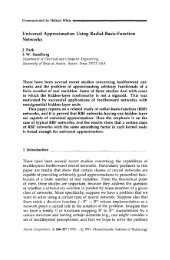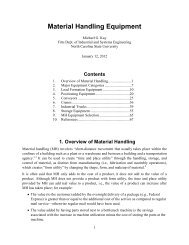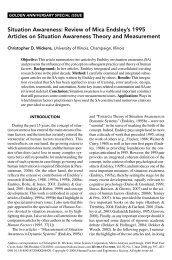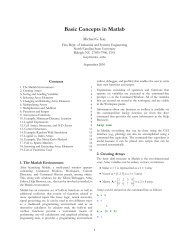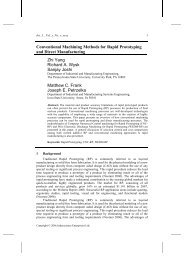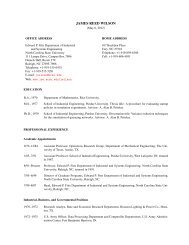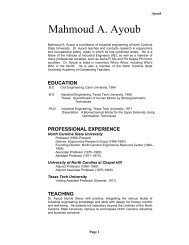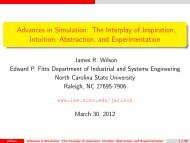Multiple Resources and Mental Workload - ResearchGate
Multiple Resources and Mental Workload - ResearchGate
Multiple Resources and Mental Workload - ResearchGate
Create successful ePaper yourself
Turn your PDF publications into a flip-book with our unique Google optimized e-Paper software.
454 June 2008 – Human Factors<br />
Bahrick, H. P., & Shelly, C. (1958). Time sharing as an index of automization.<br />
Journal of Experimental Psychology, 56, 288–293.<br />
Boles, D. B. (2002). Lateralized spatial processes <strong>and</strong> their lexical implications.<br />
Neuropsychologia, 40, 2125–2135.<br />
Boles, D. B., Bursk, J. H., Phillips, J. B., & Perdelwitz, J. R. (2007). Predicting<br />
dual-task performance with the multiple resource questionnaire.<br />
Human Factors, 49, 32–45.<br />
Boles, D. B., & Law, M. B. (1998). A simultaneous task comparison of<br />
differentiated <strong>and</strong> undifferentiated hemispheric resource theories.<br />
Journal of Experimental Psychology: Human Perception <strong>and</strong> Performance,<br />
24, 204–215.<br />
Booher, H., & Minninger, J. (2003). Human systems integration in Army<br />
systems acquisition. In H. R. Booher (Ed.), H<strong>and</strong>book of human<br />
systems integration (pp. 663–698). Hoboken, NJ: Wiley.<br />
Briggs, G., Peters, G., & Fisher, R. (1972). On the locus of the divided<br />
attention effects. Perception & Psychophysics, 11, 315–320.<br />
Broadbent, D. (1971). Decision <strong>and</strong> stress. London: Academic Press.<br />
Duncan, J. (1979). Divided attention: The whole is more than the sum<br />
of its parts. Journal of Experimental Psychology: Human Perception<br />
<strong>and</strong> Performance, 5, 216–228.<br />
Engle, R. W. (2002). Working memory capacity as executive attention.<br />
Current Directions in Psychological Science, 11, 19–23.<br />
Gawron, V. J. (2008). Human performance, workload <strong>and</strong> situation<br />
awareness measures h<strong>and</strong>book, 2nd ed. Boca Raton, FL: CRC Press.<br />
Gore, B. F., & Jarvis, P. A. (2005). New integrated modeling capabilities:<br />
MIDAS’ recent behavioral enhancements (SAW-2005-01-<br />
2701). Warrendale, PA: Society of Automotive Engineers.<br />
Grier, R. (2008). The redline of workload: Theory, research <strong>and</strong> design.<br />
A panel. To be presented at the 52nd Annual Meeting of the Human<br />
Factors <strong>and</strong> Ergonomics Society, September 22–26, in New York.<br />
Hart, S. G., & Wickens, C. D. (1990). <strong>Workload</strong> assessment <strong>and</strong> prediction.<br />
In H. R. Booher (Ed.), MANPRINT: An approach to systems<br />
integration (pp. 257–296). New York: Van Nostr<strong>and</strong> Reinhold.<br />
Hirst, W., & Kalmar, D. (1987). Characterizing attentional resources.<br />
Journal of Experimental Psychology: General, 116, 68–81.<br />
Horrey, W. J., & Wickens, C. D. (2003). <strong>Multiple</strong> resource modeling of<br />
task interference in vehicle control, hazard awareness <strong>and</strong> in-vehicle<br />
task performance. In Proceedings of the Second International Driving<br />
Symposium on Human Factors in Driver Assessment, Training,<br />
<strong>and</strong> Vehicle Design (pp. 7–12). Iowa City: Human Factors Research<br />
Program, University of Iowa.<br />
Horrey, W. J., & Wickens, C. D. (2004). Driving <strong>and</strong> side task performance:<br />
The effects of display clutter, separation, <strong>and</strong> modality.<br />
Human Factors, 46, 611–624.<br />
Horrey, W. J., Wickens, C. D., & Consalus, K. P. (2006). Modeling drivers’<br />
visual attention allocation while interacting with in-vehicle<br />
technologies. Journal of Experimental Psychology: Applied, 12(2),<br />
67–86.<br />
Isreal, J., Chesney, G., Wickens, C. D., & Donchin, E. (1980). P300 <strong>and</strong><br />
tracking difficulty: Evidence for a multiple capacity view of attention.<br />
Psychophysiology, 17, 259–273.<br />
Just, M. A., Carpenter, P. A., Keller, T. A., Emery, L., Zajac, H., &<br />
Thulborn, K. R. (2001). Interdependence of nonoverlapping cortical<br />
systems in dual cognitive tasks. Neuroimage, 14, 417–426.<br />
Just, M. A., Carpenter, P. A., & Miyaki, A. (2003). Neuroindices of cognitive<br />
workload. Theoretical Issues in Ergonomic Sciences, 4, 56–88.<br />
Kahneman, D. (1973). Attention <strong>and</strong> effort. Englewood Cliffs, NJ:<br />
Prentice Hall.<br />
Kalsbeek, J., & Sykes, R. (1967). Objective measurement of mental load.<br />
Acta Psychologica, 27, 253–261.<br />
Kantowitz, B. H., & Knight, J. (1976). Testing tapping time sharing:<br />
Auditory secondary task. Acta Psychologica, 40, 343–362.<br />
Kieras, D. (2007). Control of cognition. In W. Gray (Ed.), Integrated<br />
models of cognitive systems (pp. 327–355). New York: Oxford University<br />
Press.<br />
Kramer, A. F., & Parasuraman, R. (2007). Neuroergonomics: Applications<br />
of neuroscience to human factors. In J. T. Cacioppo,<br />
L. G. Tassinary, & G. G. Berntson (Eds.), H<strong>and</strong>book of psychophysiology<br />
(3rd ed., pp. 704–722). New York: Cambridge<br />
University Press.<br />
Laughery, K. R., LeBiere, C., & Archer, S. (2006). Modeling human<br />
performance in complex systems. In G. Salvendy (Ed.), H<strong>and</strong>book<br />
of human factors <strong>and</strong> ergonomics (3rd ed., pp. 965–996). Hoboken,<br />
NJ: Wiley.<br />
Leibowitz, H., & Post, R. (1982). The two modes of processing concept<br />
<strong>and</strong> some implications. In J. Beck (Ed.), Organization <strong>and</strong> representation<br />
in perception (pp. 343–363). Hillsdale, NJ: Erlbaum.<br />
Liu, Y., & Wickens, C. D. (1992). Visual scanning with or without spatial<br />
uncertainty <strong>and</strong> divided <strong>and</strong> selective attention. Acta Psychologica,<br />
79, 131–153.<br />
Meyer, D. E., & Kieras, D. E. (1997). A computational theory of executive<br />
cognitive processes <strong>and</strong> multiple-task performance: Part 2.<br />
Accounts of psychological refractory-period phenomena. Psychological<br />
Review, 104, 749–791.<br />
Monsell, S. (2003). Task switching. Trends in Cognitive Science, 7,<br />
134–140.<br />
Moray, N. (1967). Where is attention limited? A survey <strong>and</strong> a model.<br />
Acta Psychologica, 27, 84–92.<br />
Moray, N. (1979). <strong>Mental</strong> workload: Its theory <strong>and</strong> measurement. New<br />
York: Plenum.<br />
Navon, D., & Gopher, D. (1979). On the economy of the human processing<br />
systems. Psychological Review, 86, 254–255.<br />
North, R. (1977). Task functional dem<strong>and</strong>s as factors in dual task performance.<br />
In Proceedings of the 21st Annual Meeting of the Human<br />
Factors Society (pp. 367–371). Santa Monica, CA: Human Factors<br />
Society.<br />
North, R., & Gopher, D. (1976). Measures of attention as predictors of<br />
flight performance. Human Factors, 18, 1–14.<br />
Pashler, H. (1989). Dissociations <strong>and</strong> contingencies between speed <strong>and</strong><br />
accuracy: Evidence for a two-component theory of divided attention<br />
in simple tasks. Cognitive Psychology, 21, 469–514.<br />
Pashler, H. (1998). The psychology of attention. Cambridge, MA: MIT<br />
Press.<br />
Polson, M. C., & Friedman, A. (1988). Task-sharing within <strong>and</strong> between<br />
hemispheres: A multiple-resources approach. Human Factors, 30,<br />
633–643.<br />
Previc, F. H. (1998). The neuropsychology of 3-D space. Psychological<br />
Bulletin, 124, 123–164.<br />
Salvucci, D., & Taatgen, N. A. (2008). Threaded cognition: An integrated<br />
theory of concurrent multitasking. Psychological Review, 115,<br />
101–130.<br />
Sarno, K. J., & Wickens, C. D. (1995). The role of multiple resources in<br />
predicting time-sharing efficiency: An evaluation of three workload<br />
models in a multiple task setting. International Journal of Aviation<br />
Psychology, 5(1), 107–130.<br />
Strayer, D., & Drews, F. (2007). Multi-tasking in the automobile. In<br />
D. W. A. Kramer, D. Wiegmann, & A. Kirlik (Eds.), Attention: From<br />
theory to practice (pp. 121–133). New York: Oxford University<br />
Press.<br />
Trafton, J. G., & Monk, C. A. (2008). Task interruptions. In D. A.<br />
Boehm-Davis (Ed.), Reviews of human factors <strong>and</strong> ergonomics<br />
(Vol. 3, pp. 111–126). Santa Monica, CA: Human Factors <strong>and</strong><br />
Ergonomics Society.<br />
Tsang, P. (2006). Regarding time-sharing with convergent operations.<br />
Acta Psychologica, 121, 137–175.<br />
Tsang, P., & Vidulich, M. A. (2006). <strong>Mental</strong> workload <strong>and</strong> situation<br />
awareness. In G. Salvendy (Ed.), H<strong>and</strong>book of human factors &<br />
ergonomics (pp. 243–268). Hoboken, NJ: Wiley.<br />
Welford, A. T. (1967). Single channel operation in the brain. Acta<br />
Psychologica, 27, 5–21.<br />
Wickens, C. D. (1976). The effects of divided attention on information<br />
processing in tracking. Journal of Experimental Psychology:<br />
Human Perception <strong>and</strong> Performance, 2, 1–13.<br />
Wickens, C. D. (1980). The structure of attentional resources. In<br />
R. Nickerson (Ed.), Attention <strong>and</strong> performance VIII (pp. 239–257).<br />
Hillsdale, NJ: Erlbaum.<br />
Wickens, C. D. (1984). Processing resources in attention. In R. Parasuraman<br />
& R. Davies (Eds.), Varieties of attention (pp. 63–101).<br />
New York: Academic Press.<br />
Wickens, C. D. (2002). <strong>Multiple</strong> resources <strong>and</strong> performance prediction.<br />
Theoretical Issues in Ergonomics Science, 3(2), 159–177.<br />
Wickens, C. D. (2005). <strong>Multiple</strong> resource time sharing models. In<br />
N. Stanton, A. Hedge, K. Brookhuis, E. Salas, & H. Hendrick<br />
(Eds.), H<strong>and</strong>book of human factors <strong>and</strong> ergonomics methods (pp.<br />
40.1–40.7). Boca Raton, FL: CRC Press.<br />
Wickens, C. D. (2007). How many resources <strong>and</strong> how to identify them?<br />
Commentary on Boles et al. <strong>and</strong> Vidulich <strong>and</strong> Tsang. Human<br />
Factors, 49, 53–56.<br />
Wickens, C. D., & Alex<strong>and</strong>er, A. (in press). Attentional tunneling <strong>and</strong><br />
task management in synthetic vision displays. International Journal<br />
of Aviation Psychology.<br />
Wickens, C. D., & Colcombe, A. (2007). Dual-task performance consequences<br />
of imperfect alerting associated with a cockpit display<br />
of traffic information. Human Factors, 49, 839–850.



